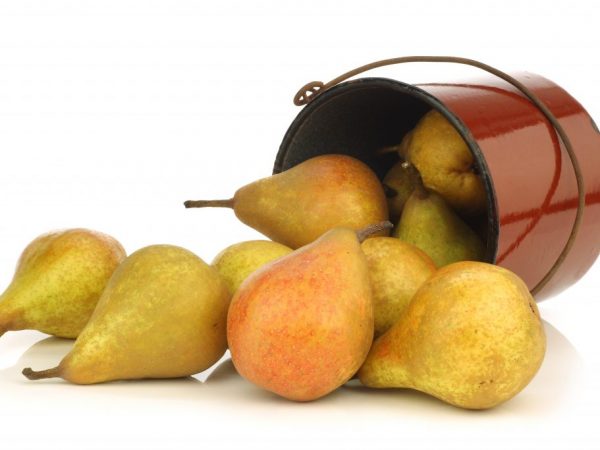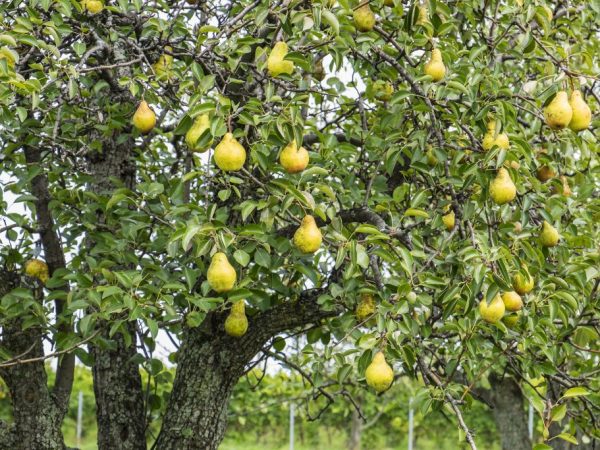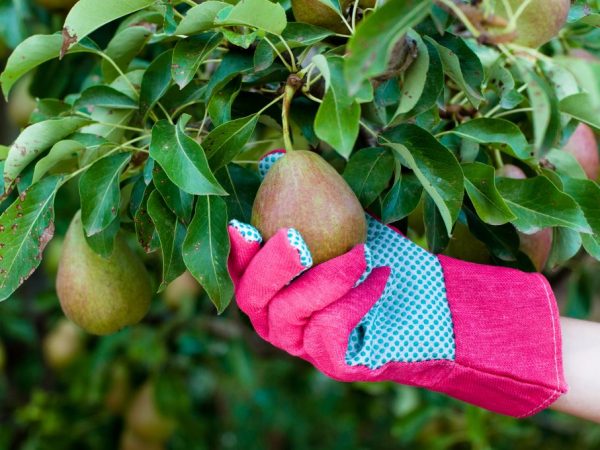Characteristics of Duchess pear
Pear Duchess is a very popular variety. The variety has several varieties. It is known for its high yield, good taste of the fruit. The variety is not whimsical to care for. Therefore, many gardeners grow it on their plots.

Characteristics of Duchess pear
Characteristics of the variety
The variety was bred by the English breeder Wheeler. Cultivated on small estates and farms.
The most popular and common varieties:
- Winter;
- Summer.
In addition to them, there are still several varieties, namely:
- Angoulême;
- Moscow Wild;
- Moscow Garden;
Some gardeners mistakenly assume that Bere is also one of these species. They are actually two different varieties.
Fruit juice is low in calories. It is used in a variety of diets. It will be useful for babies. Also, fruits have found their use in medicine. Saturated with a whole range of nutrients. They are used as one of the components of antiviral drugs. The juice has good hypoallergenic properties.
Summer variety
The species has a second name - Williams. Received it in honor of the farmer who first presented Duchess pears at an international exhibition.
The plant is unpretentious, the soil for planting can be different. But in order to achieve a high yield, it is better to choose a soil saturated with useful substances. Self-fertile - requires additional pollinators. Such varieties can act as such: Pass Crassan, Olivier de Ser, Lyubimitsa Kappa, Lesnaya Krasavitsa, Bere Ardanpon.
Description of the tree
The plant is medium-sized. The crown is wide, pyramidal in shape. There are many leaves. The bark is gray, not rough. Some shoots are arched, others are straight. Differ in thickness. They have a lot of light yellow lentils. The leaves are large, elliptical, crenate edges. Their surface is smooth and glossy. Blooms late for a long time. The size of the inflorescences is average. Resistant to temperature drops.

The plant is medium-sized. The crown is wide, pyramidal in shape
Description of the fetus
Summer Duchess fruits are set 5-6 years after planting. There can be 2-3 of them on a branch. They do not fall off for a long time, because they are well attached to the stalk. The shape is oblong, pear-shaped. The average weight is about 170 g. The skin is rough, thin. Its shade is light emerald, in the stage of full ripening it is lemon yellow, on the one hand it is characterized by the presence of a blush. The inside is juicy, granular. The pulp is creamy in color. The taste is sweet and wine. Notes of nutmeg are felt. At the end of summer, you can already feast on Williams fruits, but they are not plucked much longer.
Features of the
Pear Duchess Summer contains a lot of sugars. Eat fresh, prepare fruit salads. In processed form, these are preserves, jams, compotes, candied fruits, candies. Dried are used for muesli.
Positive characteristics of the variety:
- high yield - up to 250 kg of fruits from one adult tree;
- unpretentiousness to soil and climate;
- scab resistance;
- transportability;
- great taste;
- at low temperatures it can be stored for 1.5 months.
The disadvantages of the summer Duchess include self-infertility, aphids and carnival.
Winter grade
Originally from Belgium. Distributed in Uzbekistan, Crimea and the North Caucasus. Requires pollinators. They are Zimny Bere Ardanpon, Frenchwoman Williams.
Refers to mid-late ripening. Grows well in places protected from the wind.
Description of the tree
The tree is vigorous, branched. It grows high, but this process takes a long time. The crown is wide, pyramidal in shape. The leaves are small, oval in shape, emerald in color.
Description of the fetus
Winter fruit can be obtained 6-7 years after planting. Their mass reaches 400 g, sometimes up to 600 g. The shape is barrel-shaped. The skin is smooth and firm. The surface is smooth. The color is amber, with a blush on one side. The pulp is very juicy, melting, white. The taste is sweet with a slight sourness. Consumed fresh and processed. Dessert dishes, preserves, jams, wines are prepared. The fruits are harvested in October, when all the leaves have fallen from the tree.

The color of the fruit is amber, with a blush on one side
Features of the
Advantages of the variety:
- large-fruited;
- utility;
- frost resistance;
- long-term storage of fruits - up to several months in a cool place.
The description shows that the disadvantages are susceptibility to certain diseases, self-infertility. Demanding on the composition of the soil.
Care
In order for the Pear Duchess variety to give good yield indicators, it is necessary to provide it with optimal conditions. For this purpose, you need to carry out some activities. These varieties are cared for in the same way as other varieties.
Watering
The trees need watering. It is carried out on average three times. For Winter and Summer Duchesses, the periods of water application do not coincide. The first time to water is on the eve of flowering. The second is during fruit setting. The last time is after the harvest. The amount of water can be calculated based on the fact that for each year of life, a tree should receive 2-3 buckets of water. In droughts, you can water more times.
In order to retain moisture in the ground, and the roots do not bare and dry out, you can use mulching. Dried grass, sawdust, straw are used as mulch.
Trimming and shaping
Gardeners recommend pruning the Duchess Pear in the spring. This procedure is performed up to the age of five. The tree is given the necessary look. For the crowns of a more mature age, anti-aging and sanitary pruning is used.
The description states that a tree can be sorted according to a certain scheme. In the first year after planting, the lateral shoots above the buds and the main trunk are shortened by a quarter. In the next - the central part is 25 cm, the side parts are 5-8 cm.

The Duchess pear should be trimmed in the spring; this procedure is carried out up to the age of five.
Top dressing
The quality of the crop is affected by soil fertilization. When planting, top dressing is introduced into the pit. Every few years, chicken droppings or manure are introduced under Pears Duchesses. For 1 sq. m give 5-8 kg of organic matter. Every year (the first one is not needed) it is necessary to apply mineral fertilizers:
- potassium chloride (30 g per 1 sq. m.);
- ammonium nitrate (25 g per 1 sq. m.);
- superphosphate (25 g per 1 sq. m.).
They are brought into the groove. Its depth should be 20 cm.
If the cultivation is done in a region with cold winters, you can cover it. The lower part of the tree is wrapped in cotton cloth and newspapers. This will save him from frost and cold winds.
Diseases and pests
The description indicates that the variety is not particularly resistant to disease. During budding and after flowering, scab can attack it. The disease develops in damp cool weather. To combat it, spraying with 1% Bordeaux liquid is used. The soil is treated with 0.3% Nitrafen solution.The affected leaves must be removed and burned, because they are a source of pathogens.
The pear of this variety is also affected by the honeydew. Processing from it must be carried out when the buds have not yet blossomed. Use drugs "Oleocobrite" or "Karbofos". For 10 liters of water, give 90 g of the product. Aphid larvae are neutralized with organophosphate insecticides.
Hares love to feast on Duchess pear bark. Therefore, it is necessary to enclose it with a small fence to prevent the entry of animals.
Conclusion
Duchess pears are the standard of fruit. They are delicious and healthy. They have universal application. Growing them on your site is within the power of every gardener, even a beginner. After all, they are not whimsical in care and take root well in different areas. They bring a stable good harvest.


